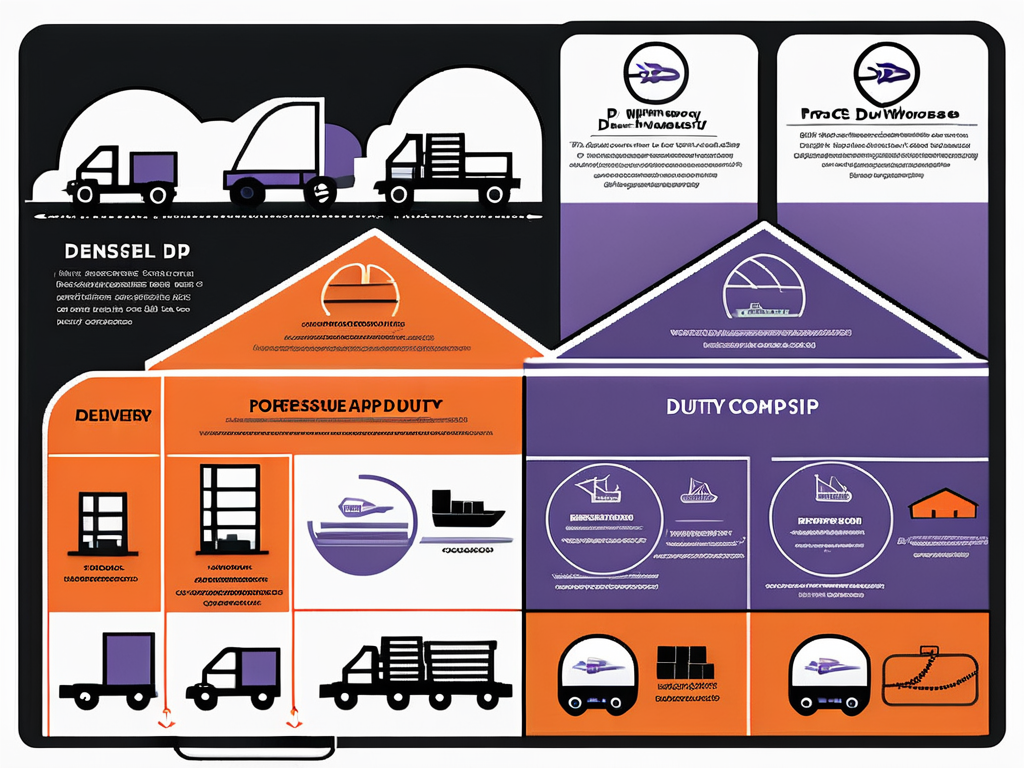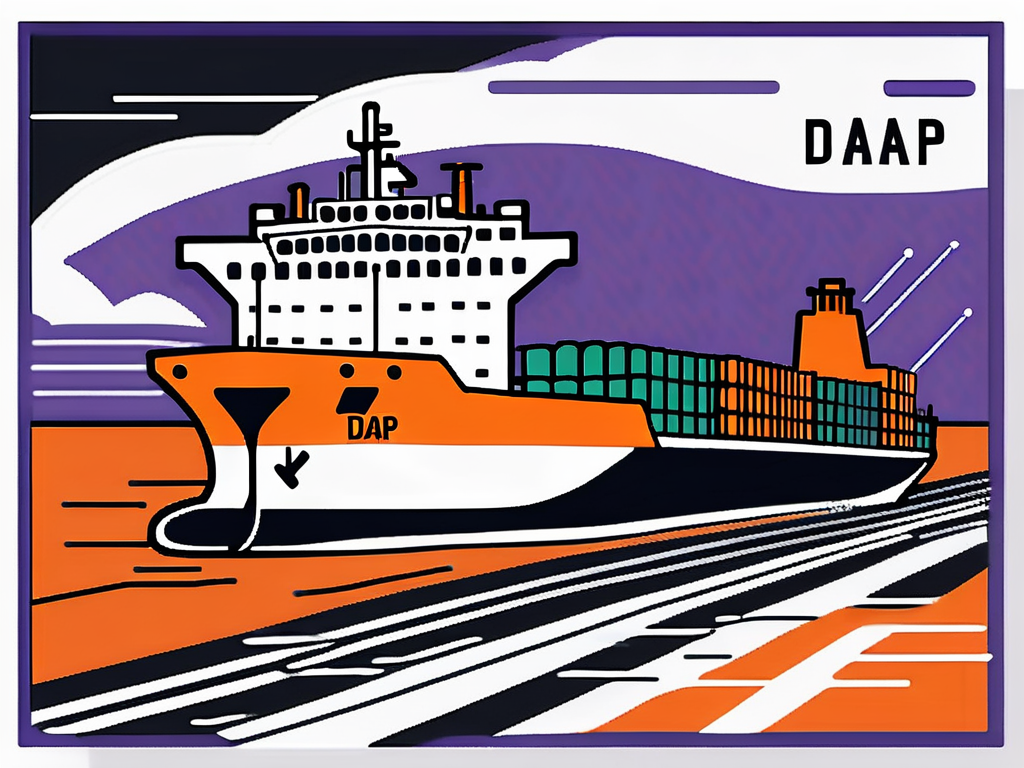What Is the Difference Between DDP and DAP?

The world of international trade can be a complex web of acronyms and jargon. Two terms that often cause confusion are DDP and DAP.
Understanding the differences between DDP and DAP is crucial for importers and exporters.
In this article, we will unravel the mystery and show what sets these two shipping terms apart, thus helping you make informed decisions for your business.
- Distinctions between DDP and DAP
- Insights into DDP: Delivered Duty Paid
- An overview of DAP: Delivered at Place
- Deciding between DDP and DAP
- Legal aspects of DDP and DAP
DDP vs DAP: Main Differences Explained Through 3 KEY Aspects
To properly assess DDP vs DAP debate, and find out the main differences between them, we need to take a look at the key business aspects of both.
1. Risk Allocation
- DDP places more risk on the seller, as they are responsible for the entire delivery process, including customs clearance. This means that the seller must navigate the complex world of import regulations and ensure that the goods reach the buyer’s location without any issues.
- On the other hand, DAP shifts the risk to the buyer, who assumes responsibility for import procedures and associated costs. Determining the optimal risk allocation depends on various factors, such as the buyer’s capabilities, familiarity with import procedures, and risk appetite.
It is worth noting that while DDP may seem like a more convenient option for the buyer, as they don’t have to worry about customs clearance, it also means that they have less control over the process.
If there are any delays or complications during customs clearance, the buyer may have to rely on the seller to resolve them, which could potentially lead to frustration and additional costs.
2. Cost Implications
- DDP generally includes additional costs for import duties, taxes, and fees, which the seller must bear. This means that the buyer knows the total cost upfront and can budget accordingly.
- In contrast, DAP allows the buyer to handle the import process, giving them more control but also making them responsible for costs associated with customs clearance, including duties and taxes.
While DAP may seem like a more cost-effective option at first glance, it is crucial for the buyer to have a clear understanding of the import regulations and associated costs in their country. Failure to account for these expenses could lead to unexpected financial burdens and delays in receiving the goods.
3. Control and Flexibility
- DDP provides the buyer with a higher level of control and convenience, as the seller handles all aspects of transportation and customs clearance. This means that the buyer can focus on other aspects of their business without worrying about logistics.
- On the other hand, DAP allows the buyer to choose their preferred logistics provider and exercise more control over the import process.
This flexibility can be advantageous, as the buyer can work with a logistics provider they trust and have a pre-existing relationship with. It also allows them to negotiate better shipping rates and have more visibility into the transportation process.
However, it also means assuming more responsibility and potential complications if not managed efficiently. The buyer must ensure that they have the necessary expertise and resources to handle customs clearance and any unexpected issues that may arise during the import process.
In conclusion, both DDP and DAP have their own advantages and considerations. The optimal choice depends on the specific needs and capabilities of the buyer, as well as the nature of the goods being transported.
It is crucial for both parties to have a clear understanding of the risks, costs, and control implications associated with each Incoterm before making a decision.
Understanding DDP: Delivered Duty Paid
DDP, or Delivered Duty Paid, is a term that indicates the seller’s responsibility for delivering goods to the buyer at the agreed-upon destination, including all costs and risks. Let’s delve into the basics of DDP.

The Basics of DDP
DDP is an incoterm that places the maximum responsibility on the seller. Under DDP, the seller is obligated to handle all aspects of transportation, documentation, and customs clearance.
The buyer, on the other hand, bears no risk or expenses past the agreed-upon destination. This includes paying for import duties, taxes, and any other fees associated with the goods’ arrival.
Responsibilities Under DDP
As the seller in a DDP transaction, you are responsible for arranging and paying for transportation from the point of origin to the destination. This includes obtaining all necessary permits, licenses, and documentation.
Additionally, you must handle customs clearance and pay any duties and taxes applicable in the buyer’s country. It is crucial to understand the legal and administrative requirements of the destination country to avoid delays and unexpected costs.
When it comes to customs clearance, sellers must navigate a complex web of regulations and procedures. Each country has its own unique set of rules, which can vary depending on the type of goods being imported.
For example, some countries have strict regulations on the importation of certain agricultural products, while others may have restrictions on the importation of certain chemicals or electronics.
Sellers must ensure that all necessary paperwork is in order and that the goods comply with the destination country’s regulations to avoid any complications during customs clearance.
Benefits and Drawbacks of DDP
The Delivered Duty Paid (DDP) shipping term comes with its set of advantages and challenges:
- Seamless Buyer Experience: DDP offers buyers a hassle-free delivery since the seller manages all logistics, which is a significant plus.
- Cost Considerations for Sellers: The convenience provided by DDP requires sellers to bear additional costs, including customs duties, taxes, and import fees, which can add up.
- Increased Seller Liability: With DDP, sellers face greater responsibility, which can lead to potential disputes or issues if complications occur during customs or transport.
- Risk of Unanticipated Expenses: Sellers need to navigate the variability of import duties and taxes across different countries, necessitating precise budgeting to avoid surprises.
- Penalties Due to Misinformation: Sellers could encounter penalties or delays if buyers do not provide accurate information or comply with regulations, possibly straining relationships.
- Popularity Despite Drawbacks: Despite its potential downsides, DDP’s straightforwardness and the ease it offers make it a preferred option for many in the trading sector.
By understanding the responsibilities and potential challenges associated with DDP, sellers can make informed decisions and ensure smooth transactions for their customers.
Exploring DAP: Delivered At Place
DAP, or Delivered At Place, is another shipping term that warrants attention. Let’s dive into the fundamentals of DAP and understand how it differs from DDP.

The Fundamentals of DAP
DAP indicates that the seller has fulfilled their responsibility by delivering the goods to the buyer at a designated place, but not necessarily cleared for import.
Unlike DDP, under DAP, the buyer assumes the risk and cost of import clearance and any subsequent duties or taxes. The seller’s responsibility ends once the goods are made available at the agreed-upon destination.
Obligations Under DAP
When entering into a DAP agreement, sellers must ensure that the goods are adequately packed, labeled, and ready for transportation.
They are responsible for transporting the goods to the designated place, usually a terminal or a specified location. However, it is important to note that the seller is not obliged to handle import formalities or pay import duties and taxes under DAP.
Pros and Cons of DAP
The Delivered at Place (DAP) shipping term presents a mixed bag of benefits and challenges that necessitate careful consideration:
- Flexibility for Buyers: DAP empowers buyers to select their preferred customs broker or freight forwarder, offering control over the import clearance process.
- Complexity and Responsibility: The autonomy comes with the burden of managing logistics, customs clearance, and related costs, potentially complicating the import process.
- Risk of Disputes: Shifting risks to the buyer could lead to disagreements or unforeseen costs, especially if import procedures encounter issues.
- Critical Seller Responsibilities: Sellers must ensure goods are adequately prepared for transit to avoid damage, relying on trusted carriers for smooth delivery.
- Buyer’s Preparedness for Import Clearance: Buyers are tasked with handling customs formalities, requiring them to provide documentation and cover duties or taxes.
- The Importance of Experienced Partners: Engaging skilled customs brokers or freight forwarders is recommended for buyers to smoothly navigate import regulations.
- Need for Clear Communication: Effective dialogue and transparent agreements on roles, costs, and timelines are vital to preclude misunderstandings or conflicts during import.
- Potential Benefits: Despite its intricacies, DAP can offer cost efficiencies and adaptability for both parties when approached with detailed planning and mutual understanding.
DAP’s viability hinges on both sellers and buyers’ readiness to tackle its complexities, underscoring the importance of strategic planning and open communication for a prosperous transaction.
Choosing Between DDP and DAP
Deciding between DDP and DAP involves weighing several crucial factors to determine the best fit for your business needs. Here’s a streamlined approach to making that choice:
- Assess Seller Capabilities and Buyer Expectations: Understand your capacity to manage logistics and consider what the buyer anticipates from the shipping process.
- Understand Customs Complexity and Regulations: Gauge your familiarity with the customs procedures and regulations of the destination country. It’s vital to consider how the intricacies of each option affect the decision-making process.
- Analyze Costs, Risks, and Control: Evaluate the financial implications, potential risks, and the amount of control each option offers over the shipping process.
- Impact on Importers and Exporters: Recognize that DDP tends to favor importers by offering a seamless experience, whereas DAP might be more beneficial for exporters, potentially reducing costs and enhancing operational efficiency.
- Legal Considerations: Be mindful of the legal aspects involved in DDP and DAP transactions, ensuring compliance with all applicable laws and international agreements.
- Consider the Level of Control: Decide whether having complete control over the shipping process (as offered by DDP) or allowing the buyer more flexibility and responsibility (as with DAP) better suits your business model.
- Evaluate the Financial Impact: Reflect on how each option influences your cash flow, especially considering upfront costs associated with DDP and the buyer’s responsibility for import duties and taxes under DAP.
Ease International Shipping Challenges with DDP and DAP Knowledge
Ultimately, the decision between DDP and DAP depends on your specific business needs and circumstances. It is essential to carefully evaluate all the factors discussed, including control, buyer’s capabilities, legal considerations, and cash flow implications.
By doing so, you can make an informed decision that aligns with your business goals and ensures a successful trading experience.